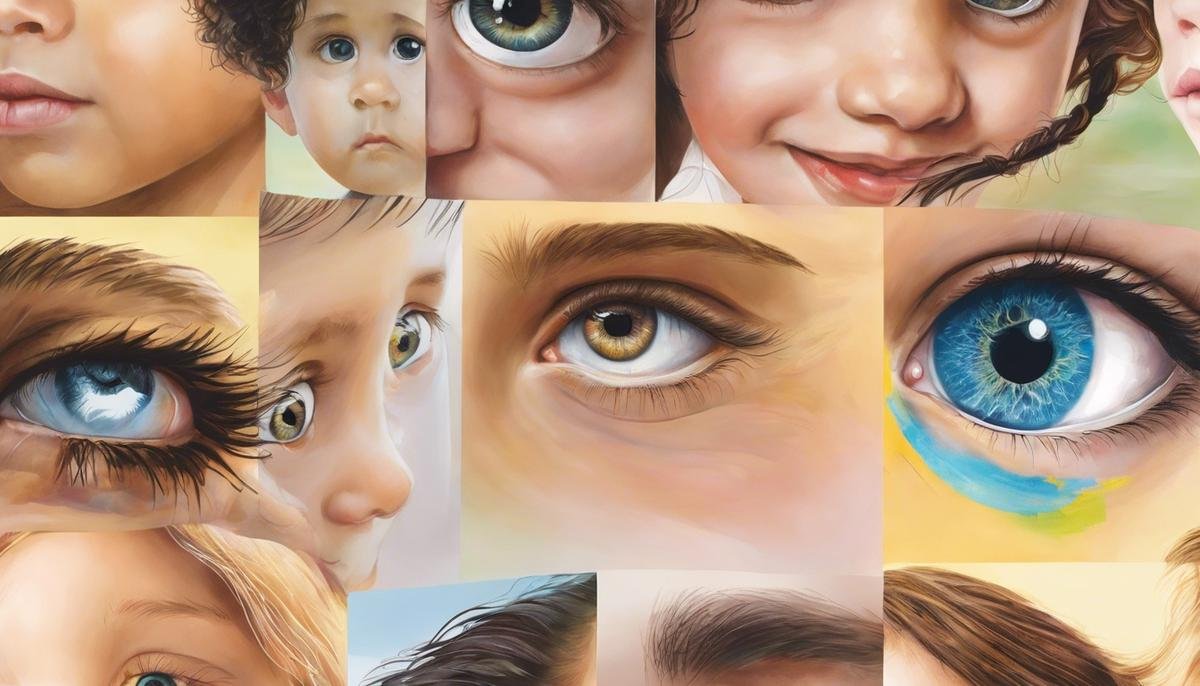
Autism, a neurodevelopmental disorder, is often associated with distinct social and communication challenges, fostering a different approach to interpersonal interactions. Among several unique elements, a specific aspect that garners significant attention is the eye gaze patterns commonly observed in individuals with Autism. Understanding these patterns is not just about spotting differences but is a crucial step in comprehending how children on the Autism spectrum perceive and interact with the world around them. This exploration extends to how these patterns impact social connections, considering the known difficulties children with Autism face in social integration. Furthermore, significant focus is given to an array of strategies tailored to nurture eye gaze development, a key component in enhancing communication skills and social engagement.
Understanding Autism and Eye Gaze Patterns
Deciphering Eye Gaze Patterns in Children with Autism
Unlocking the mysteries of the world through your child’s eyes is one of the many joys of parenting. But when your child has autism, the experience might be a bit more complex owing to unique behavioral patterns, like eye gaze, which can be especially intriguing.
Eye gaze patterns are crucial cues that offer insight into how a child perceives their surroundings. For our little ones with autism, these patterns can sometimes differ from those of neurotypical children, providing both challenges and opportunities for parents and caregivers.
Understanding Eye Gaze Patterns in Autism
Usually, infants begin to make eye contact from around six weeks old and gradually develop more sophisticated eye gaze patterns as they grow. However, with autism, this progression often takes a different path.
Research suggests that children with autism have a tendency to focus more on mouths rather than eyes during conversations. This could be due to the rich sensory input provided by observing lip movements and listening to speech simultaneously. But this doesn’t mean they avoid looking at eyes completely; rather, their attention might be divided differently.
There’s also a fascinating preference among children with autism to pay more attention to the environment’s non-social elements —think of this as the enchanting whirl of a spinning toy or the rhythmic motions of a flipping page.
Effects on Social Interaction
Eye gaze patterns in children with autism can impact social interactions, considering eye contact is a key element in non-verbal communication. Some children with autism gaze less often at people during social interactions, potentially affecting social connections. This isn’t because they lack interest in people but may be their unique way of managing overwhelming sensory inputs.
Teaching Strategies
Working with these eye gaze patterns can lead to more effective communication and deeper understanding of a child with autism’s world. For example, integrating visual tools like pictures or using demonstrations where your mouth movements can be related directly to your words could enhance the learning experience.
Also, remember that every child is unique — some would favor eye contact, while others may find it uncomfortable. It’s all about recognizing and respecting these differences, making sure to adapt to the child’s comfort levels just as you would with any other child.
In the end, the goal is fostering a nurturing and inclusive environment that gives your child the room to thrive. By understanding these unique eye gaze patterns, you can decipher a different language of affection and connection, fostering stronger bonds with your child. Experts, educators, and therapists can offer assistance constructing a tailored approach that suits your child best.
Parenthood becomes an enchanting journey towards understanding when we learn to appreciate the unique ways in which our children see the world. Understanding eye gaze patterns in children with autism becomes a critical step, towards not only understanding their unique perspectives, but also in creating a thriving environment built on love, patience, and acceptance.

Impact of Eye Gaze Patterns on Social Interaction
Unraveling the Mystery: Eye Gaze Patterns and Social Interactions in Autistic Children
Just as the endless shades of color in a kaleidoscope continuously shift and offer new perspectives, there’s an ever-changing and multifaceted spectrum to understand when it comes to parenting children on the autism spectrum. Peeping into the world of children with autism is a journey through a distinct scope, opening up new horizons on their unique perceptual landscape.
Remember though, this dynamic journey requires us to delve deeper into specific traits, which are intrinsic to their persona. Eye gaze patterns often stand out as a notable characteristic and understanding it could help in decoding social interactions of our little ones better.
Cherished ones with autism may exhibit varying eye gaze patterns compared to their neurotypical peers. A novel viewpoint is the focus on moving lips during a conversation, as opposed to the eyes. This approach is intriguing and speaks volumes about their unique perception and communicative style.
Also, children with autism bring into focus the finer details that often go unnoticed by us. Their tenderness pushes them to find solace not just in social elements, but also in non-social components of their environment. This preference enriches their experiences and offers us an invaluable insight into their unique perception.
Peeking into the world through their gaze, we see how eye gaze patterns can significantly impact their social interactions and the articulation of their non-verbal cues. Hence, understanding and catering to their unique patterns becomes fundamental in bolstering their social skills.
Education, of course, comes bearing gifts. Use the magical blend of visual aids and demonstrations to help them understand for their interpretation of the world better. Some gentle nudges, lots of patience, and oodles of love will carry them across the bridge of communication effectively and effortlessly.
Valuing each child’s comfort zone and individual distinction is key for eye contact. Every child’s preferences, openness, and responsiveness toward eye contact vary. And that’s perfectly alright! Embrace their uniqueness and provide them with an environment that cherishes and nurtures their distinctiveness.
The guidance of experts, educators, and therapists is indeed precious in devising a personalized approach. After all, a one-size-fits-all notion hardly applies here. So, keep exploring, discovering, and adapting the strategies that work best for your child.
Being a parent, of course, means embarking on a voyage of expansion and exploration. It often exposes us to new dimensions and perspectives. Understanding and appreciating our children’s unique viewpoints, especially if they are on the autism spectrum, can be a mind-expanding, awe-inspiring adventure, filled with love, growth, and joy.
Remember, even if it may look like just a tiny kaleidoscope, your child’s world is a mesmerizing land of enchanting colors. All we need to do is adjust our lens, gaze along with them, and see the breathtaking beauty of their unique world. So keep journeying, keep exploring, and keep loving. After all, the love in our hearts enchants the world around us, making it a better place for us and our little ones.

Strategies to Support Eye Gaze Development
Continuing the conversation, let’s delve deeper into tangible methods we can implement to support eye gaze patterns in children with autism. But before we do, it’s essential to remember that every child is unique, therefore approaches will vary. Embrace this diversity, it should be seen as a source of richness, not a challenge.
Engage in Joint Attention Activities: Joint attention refers to sharing focus with another on a specific subject. For instance, when a child and parent both concentrate on the same toy or book. Enhance this attention-sharing by indirectly encouraging eye contact. When sharing a focus, periodically shift your gaze between the child and the object of attention. This not only subtly encourages eye contact but also helps the child understand the relevance of eye gaze during social interactions.
Interactive Games and Activities: The stimulation of fun, engaging activities can greatly support the improvement of eye gaze in autistic children. Peekaboo, tag, or building blocks together, can naturally increase the frequency of eye contact. Such activities not only provide an appropriate context for eye contact but also link it with positive emotions and association, thus making it more appealing and less overwhelming.
Visual Support and Guides: Utilizing visual aids like appealing stickers, vibrant toys, or a colorful picture on your forehead can help a child focus on your face more. Work your way up to the eyes, emphasizing them subtly during conversation or playful activities.
Consistent Practice: Be patient, any skills are honed over time and with continued practice. Start with brief and subtle eye contact and gradually increase the duration over time. Praise every successful interaction, even the smallest one. This will help your child associate eye contact with positive reinforcement.
Involve Siblings or Peers: Games or activities involving siblings or other children can provide a less threatening, more natural environment for autistic children to practice eye gaze. Sibling interactions can be especially beneficial as they are often characterized by a deep sense of trust and comfort.
Create Comfort: Always ensure that your child feels mentally comfortable during these exercises. If they show discomfort with an exercise, take a step back and try to adapt to something more suitable. If barriers persist, remember it’s okay to reach out to professionals and consult a therapist.
Technology Integration: Technological aids like tablet apps designed to encourage eye contact can play a great role in improving eye gaze. Many of these tools make use of engaging visuals and animations that encourage children to focus on the screen and practice shifting their gaze.
Remember, these tips are suggestions, not rules. They may work differently for different children. Don’t be disheartened if you don’t see immediate progress. With patience, understanding, and dedicated practice, improvement is just a step away. The most important ingredient is love. Love is the glue that makes everything stick. Let’s strive together to create a more understanding, inclusive society where every gaze, every sound, every move holds a special meaning. Isn’t it beautiful how we perceive the world in our unique ways?

Recognizing and understanding eye gaze patterns in children with Autism renders a more comprehensive view of their unique world. The lens of their gaze offers profound insights into their social interactions, their engagement with their environment, and the ways they communicate non-verbally. It is indeed an exploration of how they see the world. Moreover, navigating this particular field paves the path to strategies that support eye gaze development – a move that might greatly impact improved social and communication skills in children on the Autism spectrum. So, it is of immense value to get acquainted with these peculiar eye-night patterns and the difference they can make, both in how we understand Autism and how we guide children with Autism towards better social interaction and communication.




